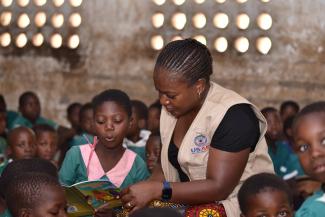OVERVIEW
The U.S. government shares the Government of Malawi’s commitment to build an inclusively wealthy and self-reliant Malawi. To achieve this vision, children and youth must have the opportunity to develop a base of essential and marketable skills so they can achieve their full potential and live healthy, more productive lives. Through its education programming, the U.S. Agency for International Development (USAID) supports the Government of Malawi to achieve its vision of providing high-quality, accessible, inclusive, and market-relevant education for all.
APPROACH
Since introducing free primary education in 1994, the Government of Malawi has made significant progress toward education reform. High enrollment rates and increasing demands on the system, however, have led to large class sizes and an inadequate supply of infrastructure, teachers, and teaching and learning materials—resulting in poor student performance, particularly in literacy.
USAID works with the Ministry of Education and other development partners at each level of education to help cultivate the next generation of Malawi’s leaders and bolster a workforce that spurs socio-economic growth. USAID programs focus on providing the foundational skill of reading in the early grades, increasing access to secondary education, and strengthening higher education institutions and their connection with jobs and employers.
KEY RESULTS
- Since 2016, the U.S. government, through USAID, has invested more than $196 million to implement the National Reading Program in all of Malawi’s 5,800+ public primary schools to improve the quality of foundational learning (especially early grade reading) for all children, including learners with disabilities. USAID supported curriculum development, trained over 76,000 teachers and administrators in early grade reading instruction and inclusive education, and printed and distributed over 28.5 million books for teachers and learners.
- The U.S. government, through USAID and the U.S. President’s Emergency Plan for AIDS Relief (PEPFAR), invested $90 million to expand and construct Community Day Secondary Schools in every district of Malawi. This investment will make secondary education more accessible for thousands of youth, keeping children—especially girls—in school longer and reducing rates of early pregnancy, early marriage, and HIV exposure. Since the project began, USAID has constructed 96 new classrooms in urban schools, completed 30 brand new rural schools, and begun planning or construction for an additional 59 brand new rural schools. The project brings schools closer to where girls and boys live, and will benefit about 30,000 students each year.
- USAID partners with U.S. universities, Malawian public universities, and Malawian private universities to increase access to and strengthen the higher education system. USAID has helped expand opportunities for vulnerable youth—including women and learners with disabilities—by supporting the Ministry of Education to roll out open and distance e-learning, and promoting strategic industry engagement in STEM education and agriculture. To date, U.S. government funding has helped more than 9,000 youth access tertiary education.

Photo Credit: USAID Global Book Alliance in Action Project
